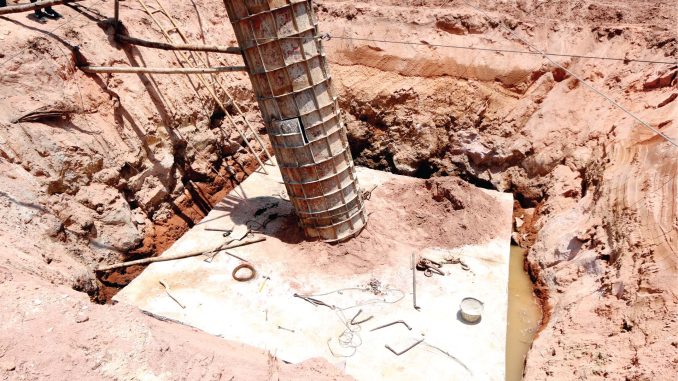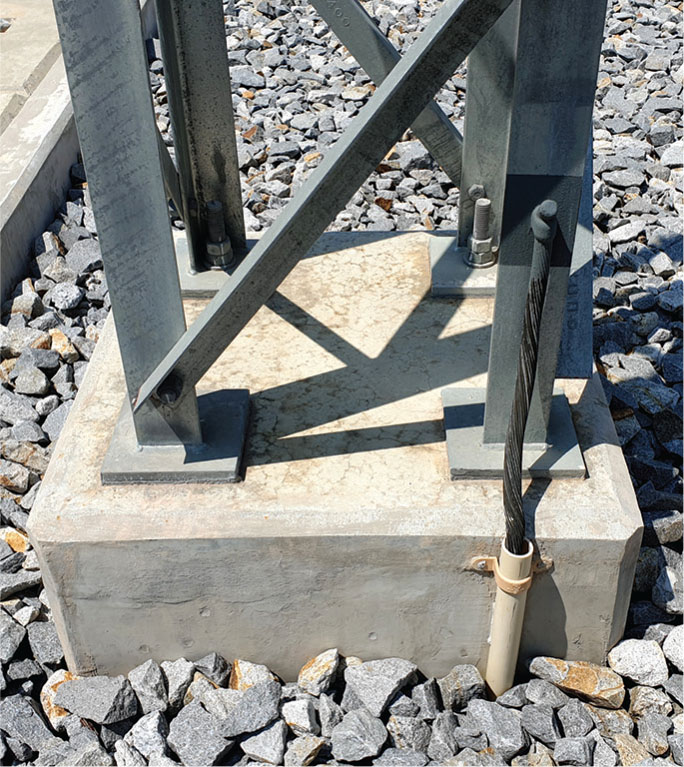
Strong tower foundations are essential for the stability of towers, especially in adverse weather conditions such as hurricanes and strong winds. Tower foundation designs should be customised to make them suitable for the local terrain and reduce the time required for construction. Over the past 20 years, tower foundations have evolved significantly. In India, some of the commonly used tower foundations are grillage, precast, reinforced cement concrete (RCC) spread, pile type and plain cement concrete (PCC). Their choice depends on the project-wise requirements.
Power Line presents an overview of tower foundation designs and their laying techniques…
Micropiling
One of the key emerging foundation designs is micropiling. Conventionally used for laying the foundation for high-rise buildings, micropiles have gained traction in the installation of transmission towers. Following the success of transmission projects developed on micro piles, the design has been replicated in several transmission projects. Micropiling has gained popularity in congested environments due to its no-noise and low vibration features. These micropiles can be used in a wide range of geotechnical conditions and that makes them an ideal option for transmission projects for diverse geographical landscapes, including deserts, mountains and marine environments.
Micropiling was undertaken in Kerala for monopole transmission towers. The transmission line project was built 60 years ago and underwent an upgradation from the 66 kV to the 132 kV level.
Grillage foundation
A grillage foundation consists of several layers of beams made of steel, precast concrete, or timber (usually laid at right angles to each other) used to disperse heavy point loads from the superstructure to an acceptable ground-bearing pressure. It is suitable in situations where the foundation of a structure is constructed as a shallow-type foundation over wet or loose soil. The deep foundation method is typically used in loose soil, whereas the grillage foundation is recommended when constructing a deep foundation is not possible. This type of foundation is considered when the foundation depth is restricted to 1-1.5 metres due to geographical barriers. It can also sustain and transfer heavy loads from the structure to large areas.
The grillage foundation can be classified into two categories, depending on the material of construction – steel grillage foundation and timber grillage foundation. The steel grillage foundation consists of two- or more layers of steel beams, with one or two-tier rolled steel embedded in cement concrete. Meanwhile, the timber grillage foundation is best suited for lightweight structures, in areas where the soil-bearing capacity is not more than 6 tonnes per square metre. A brick or block masonry wall is constructed over this foundation. It is also quite suitable for areas facing the issue of waterlogged grounds. It is used to support structures that are designed to transfer and distribute heavy concentrated loads on soil and that have a low bearing capacity. It is quite useful in firm soil areas where concreting is costly. It is a factory-made foundation that takes up less construction cycle time.
Precast foundation
This type of foundation is built off-site and is then transported to the installation location. The foundation is manufactured in factories in a controlled casting environment. It is also quite advantageous when it comes to controlling the mix, placement and curing, allowing easier and more stringent quality control.
Moreover, weather changes do not influence or delay the execution of a project. Precast foundations are quite sustainable, efficient and economical. They are especially useful in areas where the period of construction is limited. The dimensions of the foundations are governed by the uplift capacity of the cranes.
Hooks are provided for lifting.
Precast foundations offer several advantages. Since materials for multiple projects can be bought in advance by a pre-casting entity, the project developer can take the advantage of quantity discounts and lower costs. When using precast foundations, a small workforce is required with a minimum skill set. Once on-site, this type of foundation can be installed immediately as there is also no waiting time required for it to gain
strength. The modularity of precast foundations quickens the installation process. Accelerated curing leads to a significant improvement in the strength gain and reduces the time between casting the part and putting it into service. The process is tightly controlled, from material selection to consolidation to curing, creating extremely durable concrete foundations.
 RCC foundation
RCC foundation
RCC-spread foundations, made of an RCC base slab or mat, can be designed for a variety of soil conditions and may be used in locations where it is not possible to lay cement concrete footings. Various kinds of RCC-spread footings can be designed for tower foundations – single-step type, multiple-step type, and chamfered-step type. It is structurally the best, even though it can be costly. RCC-spread-type foundations are technically and economically the most favourable, especially when there are heavy loads on the foundation and the soil is of poor quality.
PCC foundation
PCC-type foundations consist of a plain concrete footing pad with a reinforced chimney. Pile-type foundations are used when the soil is weak or for special applications like river crossing towers. The stub of the tower is anchored to the bottom of the pad (either pyramidal in shape or stepped) by rods and the chimney. Although stepped footings require less shuttering material, they need more attention during construction in order to avoid cold joints between the steps. Moreover, pyramidal footings entail a costlier framework.
Direct embedment foundation
Direct embedment foundations are used for various structures including towers. The process involves digging a hole in the ground, followed by the placement of the base of the pole into the hole. This type of embedment eliminates the need for a costly anchor pole base footing. The installation time required is also less, independent of the weather conditions. It also does not have any exposed base plates or anchor bolts.
Helical foundation
Helical foundations have a low demand for resources and can be executed and tested easily. The equipment used to install helical piles is often smaller and less expensive than that used in other piling techniques. It can be installed at any time of the year and can be removed quite easily as well. These piles are made of secured steel with low-fitted steel plates welded to the base. Tension and compression are two things that allow helical piles to stabilise objects in a variety of soil conditions. For installing helical piles, machine-mounted hydraulic or electrically powered drills are used. Helical piles can be installed in confined spaces that are difficult to access. They also utilise a low-noise, minimal vibration installation method, preventing any disturbance to neighbours and protecting the existing landscape from damage. They can be used for repairing existing foundations or for building entirely new ones.
Conclusion
Designing and laying foundations is a challenging task given the risks posed by geology. Thus, selecting the most suitable foundation for towers is critical for the stability of transmission towers and lines. The lines that carry higher voltages also require bigger and heavier tower foundations. To meet the changing requirements of utilities, it is essential to focus on building appropriate and robust tower foundations.
